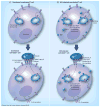Modulation of HIV pathogenesis and T-cell signaling by HIV-1 Nef
- PMID: 22844345
- PMCID: PMC3404840
- DOI: 10.2217/FVL.12.42
Modulation of HIV pathogenesis and T-cell signaling by HIV-1 Nef
Abstract
HIV-1 Nef protein is an approximately 27-kDa myristoylated protein that is a virulence factor essential for efficient viral replication and infection in CD4(+) T cells. The functions of CD4(+) T cells are directly impeded after HIV infection. HIV-1 Nef plays a crucial role in manipulating host cellular machinery and in HIV pathogenesis by reducing the ability of infected lymphocytes to form immunological synapses by promoting virological synapses with APCs, and by affecting T-cell stimulation. This article reviews the current status of the efficient Nef-mediated spread of virus in the unreceptive environment of the immune system by altering CD4(+) T-lymphocyte signaling, intracellular trafficking, cell migration and apoptotic pathways.
Figures


Similar articles
-
HIV-1 Nef and Vpu Interfere with L-Selectin (CD62L) Cell Surface Expression To Inhibit Adhesion and Signaling in Infected CD4+ T Lymphocytes.J Virol. 2015 May;89(10):5687-700. doi: 10.1128/JVI.00611-15. Epub 2015 Mar 11. J Virol. 2015. PMID: 25822027 Free PMC article.
-
HIV-1 Nef compensates for disorganization of the immunological synapse by inducing trans-Golgi network-associated Lck signaling.Blood. 2012 Jan 19;119(3):786-97. doi: 10.1182/blood-2011-08-373209. Epub 2011 Nov 28. Blood. 2012. PMID: 22123847
-
Loss of Nef-mediated CD3 down-regulation in the HIV-1 lineage increases viral infectivity and spread.Proc Natl Acad Sci U S A. 2020 Mar 31;117(13):7382-7391. doi: 10.1073/pnas.1921135117. Epub 2020 Mar 16. Proc Natl Acad Sci U S A. 2020. PMID: 32179688 Free PMC article.
-
Modulation of the immunological synapse: a key to HIV-1 pathogenesis?Nat Rev Immunol. 2007 Apr;7(4):310-7. doi: 10.1038/nri2041. Nat Rev Immunol. 2007. PMID: 17380160 Review.
-
HIV-1 Nef: Taking Control of Protein Trafficking.Traffic. 2016 Sep;17(9):976-96. doi: 10.1111/tra.12412. Epub 2016 Jun 3. Traffic. 2016. PMID: 27161574 Review.
Cited by
-
Connection Between HIV and Mitochondria in Cardiovascular Disease and Implications for Treatments.Circ Res. 2024 May 24;134(11):1581-1606. doi: 10.1161/CIRCRESAHA.124.324296. Epub 2024 May 23. Circ Res. 2024. PMID: 38781302 Free PMC article. Review.
-
Review of Current Cell-Penetrating Antibody Developments for HIV-1 Therapy.Molecules. 2018 Feb 6;23(2):335. doi: 10.3390/molecules23020335. Molecules. 2018. PMID: 29415435 Free PMC article. Review.
-
Proteomic profiling of SupT1 cells reveal modulation of host proteins by HIV-1 Nef variants.PLoS One. 2015 Apr 13;10(4):e0122994. doi: 10.1371/journal.pone.0122994. eCollection 2015. PLoS One. 2015. PMID: 25874870 Free PMC article.
-
HIV-1 Nef CAWLEAQ motif: a regulator of monocytes invasion through ENO1 modulation.Mol Cell Biochem. 2018 Oct;447(1-2):151-164. doi: 10.1007/s11010-018-3300-5. Epub 2018 Feb 5. Mol Cell Biochem. 2018. PMID: 29404888
-
Murid Gammaherpesvirus Latency-Associated Protein M2 Promotes the Formation of Conjugates between Transformed B Lymphoma Cells and T Helper Cells.PLoS One. 2015 Nov 6;10(11):e0142540. doi: 10.1371/journal.pone.0142540. eCollection 2015. PLoS One. 2015. PMID: 26544979 Free PMC article.
References
-
- Barré-Sinoussi F, Chermann JC, Rey F, et al. Isolation of a T-lymphotropic retrovirus from a patient at risk for acquired immune deficiency syndrome (AIDS) Science. 1983;220(4599):868–871. - PubMed
-
- Dragic T, Litwin V, Allaway GP, et al. HIV-1 entry into CD4+ cells is mediated by the chemokine receptor CC-CKR-5. Nature. 1996;381(6584):667–673. - PubMed
-
- Fackler OT, Alcover A, Schwartz O. Modulation of the immunological synapse: a key to HIV-1 pathogenesis? Nat Rev Immunol. 2007;7(4):310–317. Demonstrates modulation of lymphocyte signaling, apoptosis and intracellular trafficking that ensures the efficient spread of the virus in the hostile environment of the immune system. - PubMed
-
- Stevenson M. HIV-1 pathogenesis. Nat Med. 2003;9:853–860. - PubMed
-
- Zack JA, Arrigo SJ, Weitsman SR, Haislip A, Chen IS. HIV-1 entry into quiescent primary lymphocytes: molecular analysis reveals a labile, latent viral structure. Cell. 1990;61(2):213–222. - PubMed
Grants and funding
LinkOut - more resources
Full Text Sources
Research Materials
Miscellaneous
